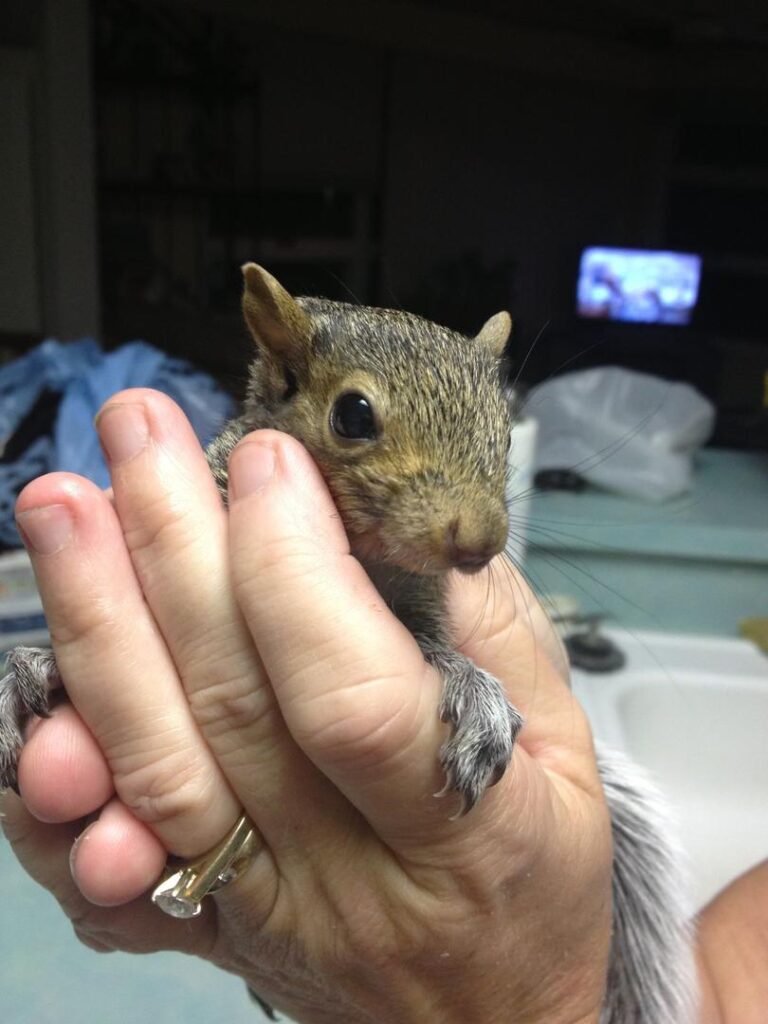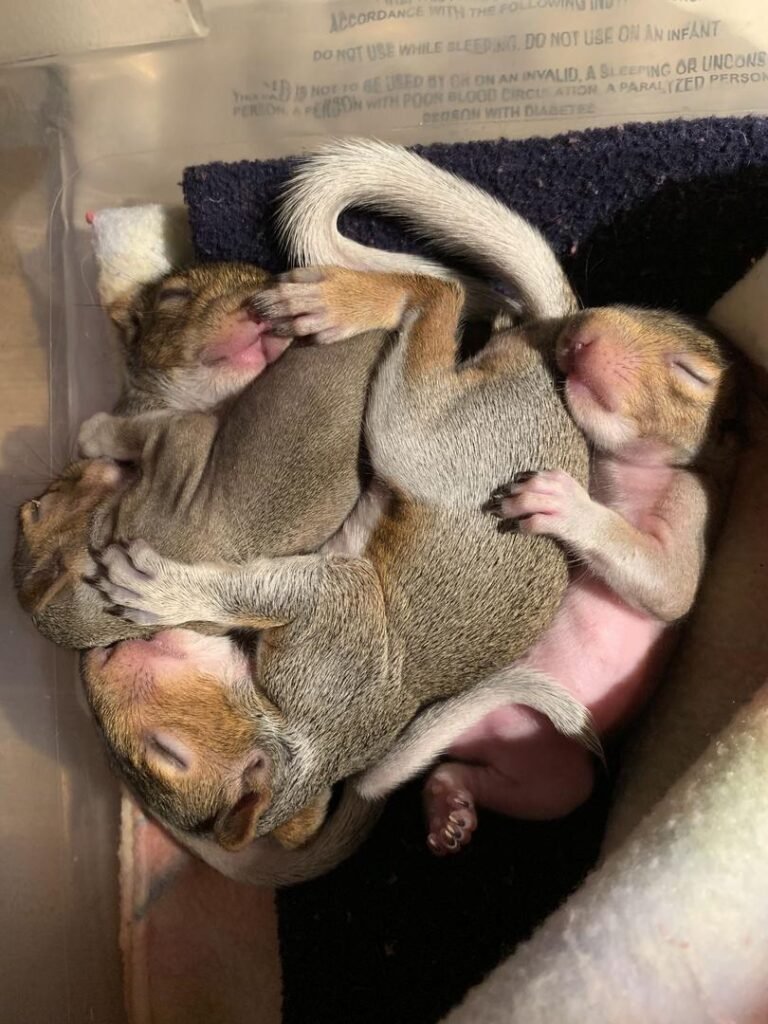How to Warm a Baby Squirrel

If a baby squirrel feels cool to the touch, it’s at risk of hypothermia a dangerous drop in body temperature that can happen quickly, especially to hairless or injured babies exposed to cold, wet, or windy conditions.
The normal body temperature for a gray squirrel is 99° to 101°F (37.4° to 38.5°C), and it’s slightly higher for fox squirrels. Before you try to feed the baby or attempt a reunion with its mother, it must be warmed to at least 99°F.
Step-by-Step: Warming a Baby Squirrel
Warm first, feed later.
Never attempt to feed a cold baby squirrel. Doing so can cause serious digestive issues and even death. Warm the baby first, then hydrate if needed.
Move the baby to a warm, quiet, indoor area.
Keep it away from noise, drafts, and bright lights.
Create a makeshift incubator using common items:
Place the baby in a small box or container lined with soft fabric (no loose threads).
Place a heating pad set on LOW under half the box so the squirrel can move away if it gets too warm.
No heating pad? Use a warm water bottle wrapped in cloth or a sock filled with dry, warm (not hot) rice.
Administering fluids or food to a cold baby, or providing inappropriate nutrition such as cows milk, juice, or human infant formula will result in death since a colder than normal core temperature slows or stops the digestive system resulting in the fluid rotting in the gut.
Inappropriate foods cannot digest properly to provide needed nutrition. Rehabilitators often lose these babies because of the actions of well meaning people as soon as we warm them up.
Precautions
The most important point to remember is that you must take care to ensure the baby is not allowed to become overheated or burned – always use common sense and monitor the heat source.
In all cases were a heat source is placed in the box with the baby, there must be ample room for the baby to move away from the heat to a cooler spot.
It very simple: Don’t cook, squish, suffocate, or drown the baby!
Immediate (Temporary) Warming Methods
Some methods of heating are better than others, but do what you can with what you have readily available. The most effective methods surround the baby with gentle warmth, not just on one side.
- Fan the baby with heat from a car heater, hair dryer or closely monitored heat lamp taking care not to overheat or burn the baby.
- Wrap a microwavable heating pack in a towel and place it in the box with the baby or part way under the nest.
- Fill a plastic bottle with hot water. Wrap it with a cloth and place it inside of the box with the baby. Ensure the bottle cannot roll on or come in direct contact with the baby unless wrapped.
- Fill a sock 2/3 full of rice and microwave on high for 2 to 2 ½ minutes. Carefully wrap the rice in a towel and place it in the box near the baby. Take Care – the rice sock gets really hot! Make sure the baby can move away from the heat.
- While holding the baby at all times, immerse the baby in a bath of warm (not hot!) water, ensuring its head is above the water at all times. The baby must be completely dry afterwards.
- In a pinch, warm the baby with your own body temperature by cupping it in warm hands or against your body – make sure it can breathe! Warning, only use this method with babies that have no fur or that you know do not have fleas, mites or other ectoparasites. These are typically easy to see by closely looking at the baby. Reference the link to debugging at the bottom of this page.
Keeping a Baby Warm
Whether the baby squirrel is kept inside a box, basket, or cage, a constant heat source must be provided until it’s fully furred and has reached at least five weeks of age. Longer is always better. Once a cold baby is successfully warmed, it’s crucial to maintain that warmth hypothermia can return quickly, especially in very young or furless babies.
Furless squirrels, typically under four weeks old, should be kept in an environment where the temperature remains close to 100°F. Their bodies are unable to regulate heat on their own, so external warmth becomes a lifeline. For slightly older, furred babies between four to ten weeks, the environment should remain gently warm ideally between 96°F and 98°F as their small bodies are still sensitive to cold.
Use soft nesting materials and a low-level heat source under part of their enclosure so they can move to a cooler area if needed. Never underestimate how quickly a young squirrel can become chilled, even if it appears healthy. Providing stable, reliable warmth is one of the most important things you can do to support its growth, comfort, and survival..

If you have more than one baby, they will typically be able to maintain their body temperature by snuggling together in warm bedding, like fleece or cotton.
For more information on providing a suitable warm environment for the squirrel, follow the link to construct a makeshift incubator.
A warning about bugs!
Squirrels are relatively disease free animals and aren’t considered to be rabies vector species (see Zoonotic Diseases for more information); however, the insects that may live on and around them in nature can carry a variety of viral and bacterial agents that are best avoided! For this reason, one of the first things most rehabilitators do once a baby is warm and stabilized is to ensure all ectoparasites are removed! Please reference the Debugging Squirrels link for more information on how to safely accomplish this task!
Dispose of the nest!
You do not need to keep the squirrel nest; in fact, I recommend you immediately toss it outside in the trash UNLESS you plan to use it in your attempt to reunite the babies with its mom or place the nest back up in the tree. It may contain a variety of vermin that you are not typically interested in rehabilitating and you certainly don’t want in your home.
DIY Incubator
Learn how to build your own incubator to safely warm baby squirrels.
Feeding Babies
Learn what, how much, and often to safely feed a baby squirrel.
Debugging
Learn techniques for identifying and debugging parasites on squirrels.
